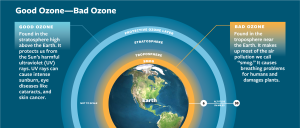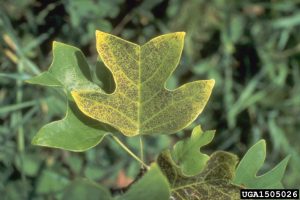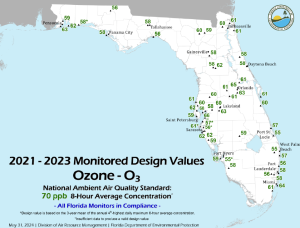One of the best parts about working at the Extension Office is all we learn from the questions we field from curious citizens. I recently had a question about ozone sensitivity in a plant and if that meant it shouldn’t be planted near a street. A little research had me learning all about this interesting topic and finding out that there are even ozone gardens being planted to monitor for air quality.
First of all, ozone (O3), also known as trioxygen, is the name we give when three oxygen molecules form a bond. It is present in low concentrations throughout the atmosphere and is important in absorbing ultraviolet (UV) radiation from the sun. This upper “ozone layer” is what we were concerned about when we noticed a hole forming in it, and regulations were put in place to minimize products that damaged this protective layer. However, ozone can also be formed lower in the atmosphere (called the troposphere) near the surface, where air pollutants, such as those related to the burning of fossil fuels and associated with smog, are produced. In this case, the ozone is considered a pollutant because it can cause health issues for animals, including humans, and can also affect plants.

Good ozone is way above our heads while the bad ozone is near the surface. Credit: National Center for Atmospheric Research.
When toxins in the environment harm plants, we call them phytotoxic. In the case of ozone, it can be phytotoxic at certain levels, and researchers are finding that certain plants seem to be more sensitive to ozone than others. The ozone damages plants by entering through the stoma, very small holes on the bottom of the leaves that the plant uses to pull in carbon dioxide and let out oxygen. Once inside the plant, ozone begins to alter normal cellular function, via oxidation, and causes visible symptoms, especially with the more sensitive plant species.

Symptoms of ozone phytotoxicity on tuliptree (Liriodendron tulipifera). Credit: USDA Forest Service – Region 8 – Southern , USDA Forest Service, Bugwood.org
These particularly sensitive species can be used as biological indicators because they show symptoms that can be easily recognized as ozone injury. Several National Parks and other public gardens have even begun installing ozone gardens, planted with these biological indicator species, to assess the air quality of the area.
Are you interested in knowing the plants that are sensitive to ozone? Here’s a list of species, selected from a National Park Service publication (Ozone Sensitive Plant Species on National Park Service Lands), that grow in the north Florida area:
- Trumpet creeper (Campsis radicans)
- Eastern Redbud (Cercis canadensis)
- Flowering dogwood (Cornus florida)
- Tuliptree (Liriodendron tulipifera)
- American sycamore (Platanus occidentalis)
- Black cherry (Prunus serotina)
- Winged sumac (Rhus copallinum)
- Cutleaf coneflower (Rudbeckia laciniata)
To answer the question that started this path down the ozone rabbit hole, the tree would likely be okay to plant near a road. The tree was not on the research-backed list and the ozone levels in our area generally low. Ozone levels in our part of the state average about 55-60 ppb (parts per billion), compared to the standard of 70 ppb, last set by the US Environmental Protection Agency (EPA) in 2008. Planting the tree may even be a fun, and useful, experiment to keep an eye on local air quality.

Ozone levels, as measured and reported by the Florida Department of Environmental Protection. Source: FDEP.
If you’re interested in more information on the impacts of ozone on plants, the National Center for Atmospheric Research has a great website, including a map of ozone gardens across the country. For more information on ozone levels across the country or in the state of Florida, the US EPA and the Florida Department of Environmental Protection (FDEP) have websites containing useful charts and maps. The good news is that surface ozone levels are generally on the decline thanks to regulations put in place to protect people and the environment. Of course, if you have any plant related questions, please contact your local extension office – we need article ideas!
- A Tale of Two Hoses - November 13, 2025
- Anthracnose and Aster Yellowing Diseases Recently Diagnosed - August 28, 2025
- Let Extension Diagnose Your Landscape Issues - May 28, 2025
